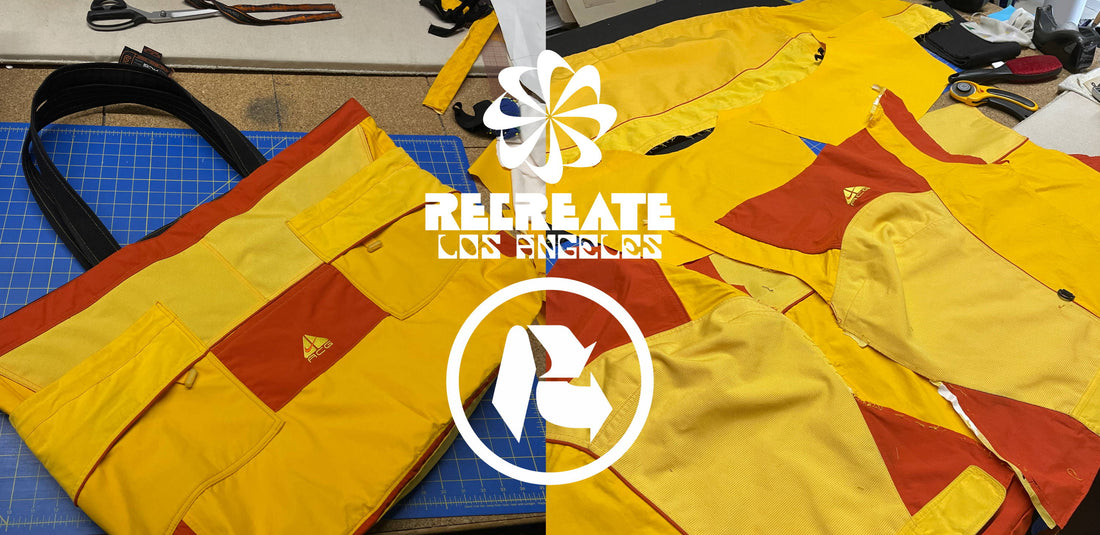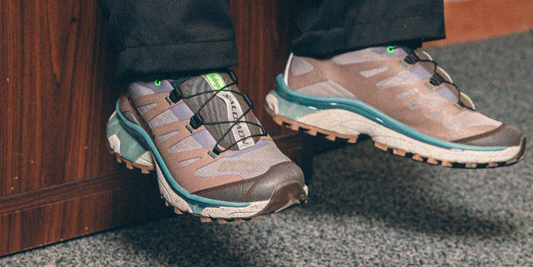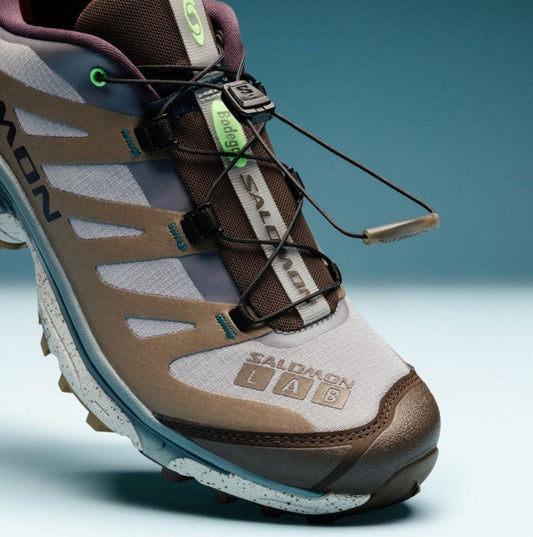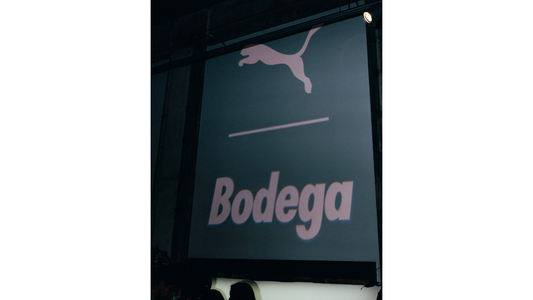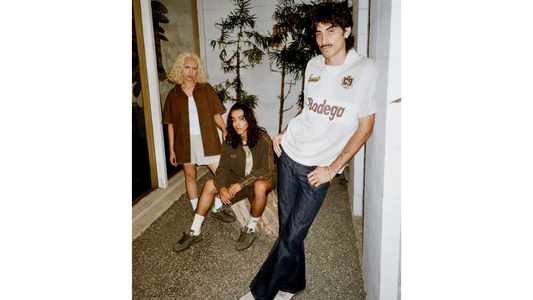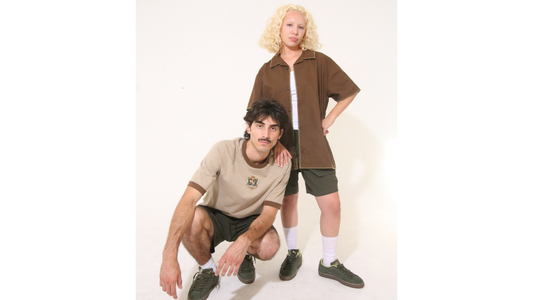Anyone who knows anything about superstition recognizes that the third time’s the charm.
Whether seeing triple dollar signs at the slot machine, hitting a home run with 2 strikes against you, or working with a leader in the textile industry as they roll out collections with upcycling entrepreneurs for the third time, 3 is a powerful place to be. And guess which one applies to us?
For the 3rd round of our Nike Re-Creation series, Beaverton’s finest have recruited LA-based Reclaimed Inc. for a collaborative collection that conjures the archeological rush of discovering gems at the bins with classic work and sportswear that will never go out of style. Together with TEG, which was instrumental in turning Nike and Reclaimed’s concepts into reality, the capsule serves as yet another powerful reminder that more often than not, the difference between your daily rotation and the discard pile is just a stale perception.
Dissecting garments to see how they tick and creating new designs from the deconstruction, Nike Re-Creation is pushing the limits of what it means to upcycle. Already proving it can be as straightforward as adding patches and incorporating visible repairs, Re-Creation has now shown that - with the help of TEG and Reclaimed Inc. - this process can happen at the granular level and from the thread up, starting with the very DNA of a garment.
As we prepare to roll out the collection, we had the chance to reconnect with Christine La, Sustainable Apparel Design Director at Nike and hear from Julian Felix, founder of Reclaimed Inc., and Gery Petrov, Technical Design Lead at TEG to learn how the project came to be, the larger role of old textiles and garments in the future of the clothing industry, and plenty more.
Thanks for taking the time Christine, Julian, and Gery!
So Julian, how did you first get into clothes?
Bodega: Julian: Originally I got into clothing/fashion because of the environment I grew up in. My aunts were listening to stuff like System of a Down, Nirvana, Blink 182, and RHCP. My uncle would take my cousin and I to school in an Oldsmobile, no paint just primer and he’d bump Too $hort or Eazy E every day. I remember my dad and uncle always wearing Ben Davis, I paid attention to things like that. At that time (2002) I was really into band tees and studded bracelets, I was getting most of my gear from Hot Topic or Red Zone.
Bodega: Cool and when did vintage enter the picture?
Julian: Vintage clothing came into the picture when I started living with my mom. She would take me to thrift stores after school, this was around 2007-2008 when they weren’t as popular. What got me hooked was finding this vintage red Guess denim jacket. I had never seen anything like it at the time.
Bodega: How did this all lead to upcycling for you?
I started upcycling with my first brand (2014) where I was taking the resources I had at the time like denim pants for example, making patches out of them and applying them to bomber jackets. Not knowing I was being sustainable, more so just using what I had access to.
Bodega: Christine, why is Julian/ Reclaimed Inc. a perfect fit for Nike’s Re-Creation Program?
Christine: When it comes to our sustainable efforts at Nike, there’s a sense of urgent optimism that drives us. The future is not set in stone. We all have the ability to create our own story. In essence, the opportunities to create a better future are limitless. That limitless space of creativity and potential is where the Re-Creation Program lives, and Julian’s work fits this space perfectly.
Bodega: What was it like working with him for this latest chapter of Nike’s Re-Creation Program? Can you describe the collaborative process?
Christine: Outside of the ‘local for local’ rule and design standards for production methods, we’ve given Julian the runway to transform our deadstock through his eyes. With that said, this collection has been in the making for roughly 2 years. Mainly because we were and still are establishing what the best process is for Re-Creation, from end to end. For example, we started our collaboration with Julian building designs we were both pleased with, but ultimately couldn’t find enough of the right mix of deadstock product and colors to create those designs with. So, we went back to the drawing board, this time starting with gathering a surplus of deadstock product and then designing from there. All the while making sure that all the designs maintained a sense of cohesion and felt authentic to both Reclaimed and Nike. Lots of starts and stops and starting over until we both felt like the designs were finally right. Add on to that the process of ensuring that all designs are manufacturable. It’s been challenging but worth it and worth the wait.
Bodega: What about you Julian, what was it like working with Nike Re-Creation for this upcoming project?
Julian: It’s been an amazing experience working with Nike Re-Creation. This is something I would’ve never imagined. I’ve learned a lot working alongside Christine La and her team for the past year. One thing that stood out to me was how she always found ways to improve a garment. Whether it was slightly adjusting the shape of a collar or dropping a shoulder seam by an inch. I was able to see how she broke down samples and made proper adjustments.
"
"I think we created a new sub-genre of workwear through Nike’s rich archive of signature sport details and innovative construction."
"
Bodega: Coming from a technical design background at TEG, what did you see as your role in this latest Re-Create project Gery?
Gery: This project presented the team with a unique opportunity to be involved in a collaboration where pieces were deconstructed to create entirely new designs. Adapting new patterns and producing garments with detailed specifications while fully utilizing the deconstructed components was an exciting challenge.
Bodega: One of Julian’s signatures is combining multiple design influences into each one of his pieces, whether it be pairing trucker jackets with puffers or incorporating fishing vests with fleeces, how did his approach to upcycling inform the collection?
Christine: We love Julian’s signature pairing approach. Going in, we were also sensitive to the fact that his original concept has been reappropriated by other brands in the past. Teaming up with Julian, we wanted to develop a new and unique point of view distinct to the work between Reclaimed and Nike while still combining his multiple influences: the popular and obscure with utility and sport. We landed on an elegant way to pair these familiar and incongruent concepts in unexpected ways. I think we created a new sub-genre of workwear through Nike’s rich archive of signature sport details and innovative construction.
Julian: The idea of combining different garments together came from a Levi’s jacket a friend had given to me. It was lined but not reversible. That's what inspired me to start inlining denim jackets with other outerwear pieces. (2016)
One thing that I’ve consistently done with many of my pieces is mix different textures together. You’ll find that throughout this Nike project whether it’s a combination of canvas and wool or corduroy and canvas.
Bodega: In addition to a new creator, how has Nike Re-Creation evolved from the last collection?
Christine: This collection has evolved in material and technology in 2 ways.
Firstly, people normally don’t associate upcycling with digital as it’s been so inherently analog in process. With Reclaimed, to explore saving materials in the development process where possible, we started with drafting initial designs digitally. This enabled us, to effectively develop the right fit, proportions, and design lines before making real prototypes, further helping to reduce waste in the creation process.
Second, this collection continues to explore mixing diverse materials. In some of the jacket styles, we mash together deadstock chore coat canvas, wool from varsity jackets, and deadstock corduroy from LA. These explorations also required us to tap into different methods of creation, depending on the materials used. So, for example, for the items using wool, we had to apply certain classic tailoring techniques that you would see in menswear suiting to get the right structure and fit. I would say a lot of the innovation this time around, lies in the nuances of fit and construction.
Bodega: With all this design, construction, and material talk, we have to ask -what pieces are you guys most excited by with this drop?
Julian: Since the inspiration for this collection was my love for sports and workwear, if I had to highlight one piece it would be the Rugby Work Jacket which features wool sleeves and stripes reconstructed from Nike varsity jackets.
Christine: I’d call out the Packable Afterhood for sentimental reasons. It was one of the very first concepts Julian made for this collaboration. It’s taking a covetable, oftentimes rare vintage design and combines it with the packable feature that you’d only see in lightweight Nike performance styles such as ACG and Running. It’s weird and fun and most importantly, it works!
My other favorites are the Yacht and Rugby Work Jackets. In addition to these styles incorporating men’s tailoring treatments, they use up most if not all of the original deadstock, meaning you will see some of the original marks of the sewing needle where the seams were dissembled. Through these methods, we ended up with less waste in the manufacturing process while letting each style retain some of the hallmarks of its first life.
Gery: For me it’s the Yacht Jacket and the Rugby Work Jacket. They are very unique designs putting a twist on classic styles.
"I hope people see that as big as a company Nike is, they’re taking the initiative toward a more sustainable future while giving designers a platform to showcase themselves."
Bodega: Is there anything you hope the consumer takes from this collection?
Julian: I hope people see that as big as a company Nike is, they’re taking the initiative toward a more sustainable future while giving designers a platform to showcase themselves.
Christine: We hope consumers start to see their old clothes in a different light through Re-Creation, considering unused clothes as a new resource or material versus something to be discarded.
Gery: We hope that consumers will see the opportunity for the fashion industry to create timeless pieces with a focus on sustainability and to feel part of the solution that Nike, TEG, and Reclaimed Inc. are providing in response to this important issue.
Bodega: As the program continues to grow, why is it important to reach out to the community and build with designers and creatives who upcycle as opposed to having it be an in-house project?
Christine: There’s an organic specialized network, an eco-system for upcycling that’s unique to each city. From local material and trims suppliers, designers, and creatives to makers. What we all have in common is the knowledge that through our efforts, we have the potential to make a positive and lasting impact that’s larger than ourselves. We want to preserve this ecosystem and find value in authenticity. In working with these communities, we hope to be able to combine and accelerate these efforts to create even more positive change.
Bodega: With the trend of second-hand and vintage clothing growing in popularity amongst younger generations every day, why is it the perfect time to lay the groundwork for more sustainable manufacturing in the clothing industry?
Christine: Knowing that trends tend to ebb and flow, we see that the demand for second-hand, vintage, and upcycling lies in the fact that it’s an increasingly sensible and appealing choice based on both its abundance and scarcity, without getting too gloom and doom over the climate crisis. I think what we are now experiencing is a gradual value shift in consumer sentiment and we will continue to push forward in our sustainable efforts, partnering with athletes across our key cities.
Gery: It is the perfect time because it shows that companies are listening to important issues among consumers and that we take seriously our collective responsibility to deliver apparel that people can feel good about purchasing with less impact on the environment, moving the industry further from "fast fashion".
Julian: The younger generation seems to understand that sustainability and fashion go hand in hand. Kids are getting creative with their outfits and what kind of clothing they wear. I believe this is a great moment to emphasize that and create pieces that are fashionable while practicing more eco-friendly ways to manufacture.

